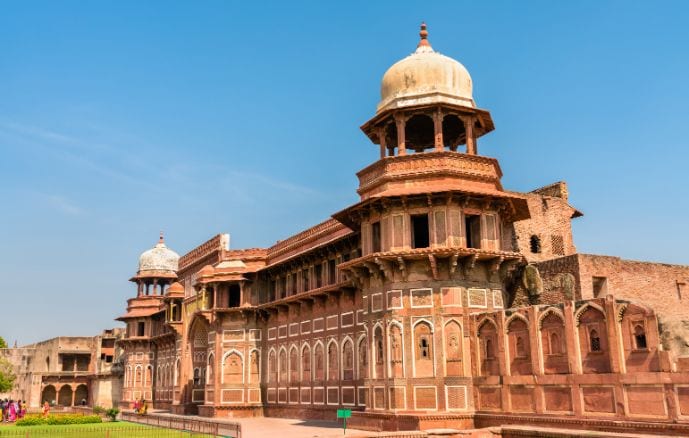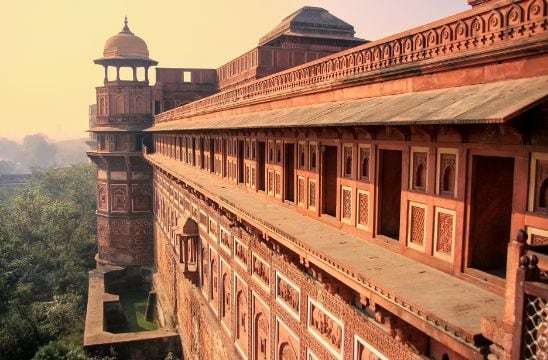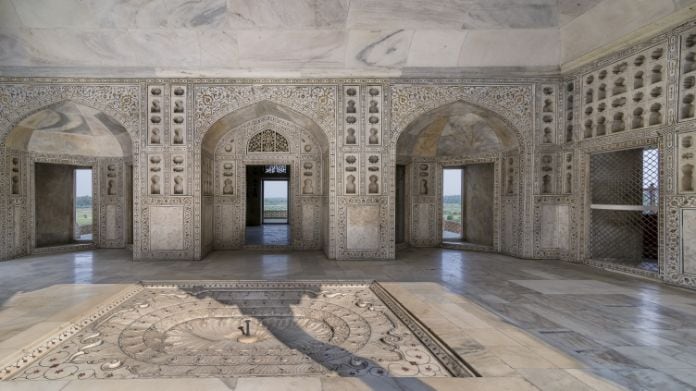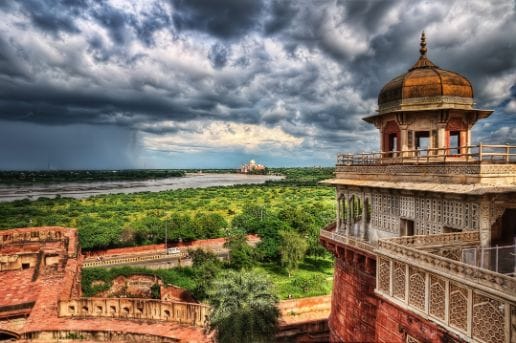Overview
A place of residence of the Mughal emperors till 1638, this 16th century fort was built by Akbar and is now a World Heritage Site.
Suggested Duration - 2 to 3 hours
What To Expect?
History enthusiasts will love the intricate architecture and old-world charm of this monument. The red stone façade houses many stories, and is a photographer's delight.
Tips
- Read about the history of this fort before you plan a visit for a more wholesome experience.
- Eating and smoking is not allowed inside the premises.
- Preserve the beauty of the monument by not vandalizing or littering.
Agra Fort, Agra Overview
The Awe-inspiring Agra Fort or Red Fort of Agra is nestled in India's captivating city, Agra, designated by UNESCO as a heritage site. The spectacular edifice serves as supreme evidence to prove grandiosity that embodies charms linked with the Mughal era. It boasts architectural marvels artfully fashioned into shape with exceptional craftsmanship using fine-grained sandstone predominantly accentuated by striking red tinges. Its magnificence is simply astoundingly placed boldly at the Yamuna riverbank. It exemplifies beauty blended into royal sophistication crafted masterfully into the finest work representing exquisite artistry, and profound designs dating back to the sixteenth century when Emperor Akbar established it for bolstering military Strength. The fort served as the main residence of the Mughal emperors until the capital was shifted to Delhi.
Agra Fort is known for | It is famous for its various palaces, halls, and mosques that showcase exquisite Mughal architecture. |
Timings | Opens: 6:00 AMCloses: 6:00 PMSound and Light Show timings: - |
Entry Fee | Indian Adults: INR 40Foreign Adults: INR 550 |
Tips | The best time to visit this Fort is during the winter months from October to March. |
Require Time | 3-4 hours (approx.) |
Restricted Items | Weapons and firearms, explosives and flammable substances, sharp objects, large bags and backpacks. |
More About Agra Fort
As visitors explore Agra Fort, they can also witness the beautiful Musamman Burj, a marble tower where Emperor Shah Jahan was imprisoned by his own son. From this tower, there is a breathtaking view of the Taj Mahal, another iconic symbol of Agra. An expansive domain measuring nearly 94 acres is home to a one-of-a-kind structure, Agra Fort, an impressive fortress incorporating several attractions like eye-catching palaces decked out with intricate decoration work and vibrant landscaping featuring pockets of beauty at every turn, making it very picturesque indeed. With so much on offer, there's no skipping visiting here, as every nook testifies to the ancient charm which still captures audiences today.
Architecture of Agra Fort
The architecture of Agra Fort is a remarkable blend of various styles, reflecting the influences of different periods and rulers. Primarily constructed using red sandstone, the fort showcases a fusion of Islamic, Persian, and Hindu architectural elements. Boasting immense walls that soar to roughly 70 feet in height, the fort envelops an expansive network of constructions and edifices. To enter this fortress, one must pass through the Amar Singh Gate, which serves as the threshold for the foremost courtyard, typically referred to as Hathi Pol (meaning Elephant Gate). From there, visitors proceed to the inner complex through another impressive gateway called the Delhi Gate.
The architectural highlights of Agra Fort include the Diwan-i-Aam (Hall of Public Audience) and the Diwan-i-Khas (Hall of Private Audience). The Diwan-i-Aam features a collonaded hall with beautifully carved pillars and arches. The Diwan-i-Khas, on the other hand, is known for its intricately designed marble columns and a central marble platform where the emperor would hold private meetings. The fort also boasts stunning palaces, such as the Khas Mahal and the Jahangiri Mahal.
Best time to visit Agra Fort
A wise choice for travellers looking to explore Agra Fort would be scheduling their itinerary during winter between October and March. Occurring during this period are agreeable weather patterns with temperatures ranging between 10-25 degrees Celsius, optimal for leisurely wandering through the intricate fortified complex. A frequent destination amongst tourists, the area provides visitors with awe-inspiring vistas and structures symbolic of Indian history and culture. Winter is considered the peak tourist season in Agra, including Agra Fort, due to the favourable weather conditions. The cool temperatures also make it more enjoyable to navigate the fort's expansive grounds and admire the architectural marvels.
How to reach Agra Fort
Agra Fort has its own railway station called Agra Fort Railway Station, which is well-connected to major cities in India. Numerous trains, some of which are superfast or express, run to and from Agra Fort Railway Station. Agra is well-connected by road networks, making it easy to reach Agra Fort by road. The city is connected to major cities in India through national highways. You can either drive your own vehicle or hire a taxi to reach Agra Fort. Regular bus services are also available from nearby cities to Agra. Once you reach Agra, you can use local transportation options such as auto-rickshaws, cycle rickshaws, or taxis to reach Agra Fort. These are easily available and can take you to the fort's entrance gate.
Tips for Visiting Agra Fort, Agra
- It is advisable to reach early in the morning to avoid crowds and enjoy a peaceful experience.
- Purchase your entry tickets in advance to save time and avoid long queues. You can also consider buying a combined ticket that includes entry to other popular attractions in Agra, such as the Taj Mahal.
- Hiring a knowledgeable guide or opting for an audio guide can enhance your visit to Agra Fort.
- Carry sunscreen, a hat, and sunglasses to protect yourself from the sun while exploring the fort.
- Respect the heritage by not touching or damaging any structures and following the rules and regulations set by the authorities.
- Carry a water bottle to stay hydrated during your visit.
- Take care of your belongings and keep them secure while exploring the fort.
Nearby tourist spots of Agra Fort
- Taj Mahal
- Mehtab Bagh
- Guru Ka Taal
- Jama Masjid
- Itimad-ud-Daulah's Tomb (Baby Taj)
- Akbar's Tomb, Sikandra
- Chini Ka Rauza
- Ram Bagh
- Moti Masjid
- Jahangir Mahal
FAQs - Frequently Asked Questions about Agra Fort
How do you plan for the perfect trip to any destination?
How to choose a destination to travel to?
How to explore a place by yourself?






